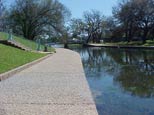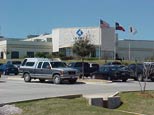| COVER STORY, APRIL 2005
PROMOTING GROWTH
Economic development agencies bring new projects to Amarillo, Bastrop and Burnet.
Luci Cason
Texas Real Estate Business recently spoke with economic development organizations in Amarillo, Bastrop and Burnet to find out what strategies they are using to promote economic growth in their areas.
Amarillo
Located in Texas’ heartland, Amarillo has a reputation for energy production and agriculture, but is currently maintaining steady economic growth by attracting aviation-related manufacturers, corporate operations, technology development companies and food processing companies. Much of this growth has been facilitated by the city’s economic development corporation.
The Amarillo Economic Development Corporation was established in 1989 after voters in the city of more than 200,000 took advantage of a law passed by the Texas legislature that year allowing the creation of a local economic development sales tax. So far, it looks like that investment has paid off.
Bell Helicopter Textron has begun site work on its expansion of facilities first built in 1998. The expansion is a $10 million project. As part of the Marine H-1 Helicopter Upgrade Program, the company will re-manufacture the U.S. Marine Corps’ fleet of 180 AH-1 Super Cobra and 100 UH-1N Huey utility helicopters. Bell anticipates its total Amarillo employment could exceed 1,700 by 2011.
Ben E. Keith, a food service products distributor, will break ground in April on a new $20 million, 274,000-square-foot warehouse and distribution facility on a 53-acre parcel provided by the Amarillo EDC. The parcel is part of a new EDC-owned, 340-acre, master-planned industrial park. The EDC hopes the park will attract more companies that have distribution as a significant part of their business.
“We want to assist companies in creating new jobs within the community and provide employment opportunities that will provide better wages,” says Steve Pritchett, vice president of the Amarillo EDC. “We also want to continue to promote diversification of the local economy.”
“Presently, we try to identify companies that have exhibited behaviors that are indicative of a need to expand or establish a new operation in the foreseeable future,” he says. “We try to establish contact with those companies and determine if expansion is, in fact, on the horizon. If so, we demonstrate how Amarillo can meet that particular company’s needs.”
Many businesses find that Amarillo provides a low-cost operating environment, with its low energy and construction costs. But Amarillo’s biggest draw might be the quality of its workers.
“Our employers tell us that when they compare their Amarillo operations with their operations in other locations, workers here are far more productive than in other communities,” says Pritchett. “Bell Helicopters is a good example of that. They’ve discovered that they can produce more aircraft with fewer people in Amarillo than they can in other locations. Lots of places tout their work ethic, but here it’s really true.”
Burnet
 |
In 1995, Burnet used a grant to improve Hamilton Creek, which runs through town. The Riverwalk project features lighted concrete walkways and playscapes. The city recently purchased more creek frontage and plans a second phase, which will end behind the new $5.5 million Recreation Center.
|
|
Situated in the Texas hill country about an hour northwest of Austin, the small city of Burnet is looking for a few good retailers. Ron Faulkenberry, the city’s director of economic development, says that the natural beauty of the city is one of its biggest draws. Known as the Bluebonnet capital of Texas, Burnet is located within a short drive of three lakes.
“We’re very conscientious of trying to develop some sustainable and controlled growth with the aesthetics of the area taken into account,” says Faulkenberry.
With that goal in mind, the sales-tax-sponsored economic development department recently contracted with a private company — Angelou Economics — to lay out a comprehensive economic development plan for the city and suggest several economic goals that Burnet should work to achieve. These goals include attracting more retail businesses and more manufacturing, building more affordable housing, and creating more recreational and entertainment venues. It looks like Burnet is on its way to accomplishing these goals. The Angelou study found that the city’s retail sales have grown at an exceptional rate, doubling during the past 10 years.
The city’s population of just over 6,000 has seen a 25 percent increase within the past several years, and that growth looks to continue. Currently, a planned residential development called Eagle’s Nest, developed by Austin-based Steve Hurst, will add almost 400 homes and additional retail space to the city.
 |
In Burnet, ATMI, which provides specialty materials and services to the semiconductor industry, hopes to expand its campus soon by building several more buildings. The company opened a $30 million facility in Burnet in 2002.
|
|
Accessibility will be key to the city’s growth. Many of Burnet’s residents commute to Austin, and Highway 281, which runs through Burnet, is becoming a popular alternative to Interstate 35, which connects Dallas and San Antonio. Low crime rates and a hometown feel are other pluses that are drawing in economic development.
Stealth Products, which manufactures accessories for battery-operated wheelchairs, recently opened its 21,000-square-foot corporate offices in Burnet after moving from nearby Marble Falls.
ATMI, which provides specialty materials and services to the semiconductor industry, opened a $30 million facility in Burnet in 2002, and hopes to expand its campus soon by building several more buildings, says Faulkenberry.
In an effort to attract retailers, Faulkenberry recently joined The International Council of Shopping Centers (ICSC) to network with retailers and shopping center developers and has been working with several restaurants and department stores, which said they would consider locating in a small market such as Burnet. Faulkenberry is working to attract one or two national retailers in hopes that others will soon follow suit.
Says Faulkenberry, “We’re a can-do community and we’re looking for good businesses.”
Bastrop
Bastrop is another Texas city that has taken advantage of the economic development sales tax.
“The citizens saw the need for the creation and retention of jobs and improving the quality of life here,” says Joe D. Newman, president and CEO of the Bastrop Economic Development Corporation. The Bastrop EDC was founded in 1995 and covers an area that includes about half of Bastrop County and a population of about 35,000.
The city of Bastrop — with a population of 7,700 — may be small, but its trade territory includes 137,000 people. And Bastrop County is the ninth fastest growing county in Texas — out of 254 counties — and the 36th fastest growing county in the nation. In fact, census figures show that the area grew by more than 50 percent between 1990 and 2000.
Thirty miles southeast of Austin, Bastrop is the second-oldest incorporated city in Texas and is home to the Lost Pines Forest. Stephen F. Austin founded the city in 1832 and thought about making Bastrop the capital of Texas, but then decided to move farther up the Colorado River to Waterloo — which later became known as Austin.
It’s these demographics and rich natural history and beauty that have helped the Bastrop EDC attract retailers, restaurants, hotels and energy companies through programs like the Bastrop Expansion and Retention program (BEAR) and by offering free land in its 250-acre industrial park. Its growth that means Bastrop-area residents won’t have to travel to nearby Austin to meet their everyday needs.
The EDC recently negotiated incentives for The Lost Pines Resort and Spa, a $135 million, 405-acre project by Hyatt Hotels and Dallas-based Woodbine Development Corporation. The resort, which will open in 2006, will be adjacent to the 1,100-acre McKinney Roughs Nature Park along the Colorado River. The 491-room resort will include a golf course, spa, water park and 16 miles of hiking trails.
The EDC is also currently working with Simon Property Group on a planned 1 million-square-foot, open-air regional mall.
The city has attracted several biotech companies including the MD Anderson Cancer Research Center, BioCrest/Stratagene, The Coghlan Group, University of Texas Veterinary Science Park and Cenatron Diagostics. Next year, Garland-based Rockwall Hospital Corporation will open a $7 million, 28,000-square-foot hospital in Bastrop.
But it’s not only business that Bastrop is attracting. Along with shopping malls and office complexes has come an explosion in residential growth.
Sabine Investment Company is currently developing The Colony, a 2,200-acre project that will include 4,000 houses and will be built-out over the next 15 years. Sabine also has plans to develop more than 400 homes and as many as 700 apartments behind the retail space of its Hunters Crossing center, which includes The Home Depot and Chili’s. Austin-based Walters Southwest is also developing the 750-acre Bastrop Village, which will include up to 1,000 homes.
©2005 France Publications, Inc. Duplication
or reproduction of this article not permitted without authorization
from France Publications, Inc. For information on reprints of
this article contact Barbara
Sherer at (630) 554-6054.
|
